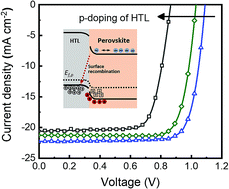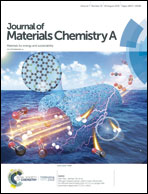p-Doping of organic hole transport layers in p–i–n perovskite solar cells: correlating open-circuit voltage and photoluminescence quenching†
Abstract
Doping is a widely implemented strategy for enhancing the inherent electronic properties of charge transport layers in photovoltaic (PV) devices. Here, in direct contrast to existing understanding, we find that a reduction in p-doping of the organic hole transport layer (HTL) leads to substantial improvements in PV performance in planar p–i–n perovskite solar cells (PSCs), driven by improvements in open circuit voltage (VOC). Employing a range of transient and steady state characterisation tools, we find that the improvements of VOC correlate with reduced surface recombination losses in less p-doped HTLs. A simple device model including screening of bulk electric fields in the perovskite layer is used to explain this observation. In particular, photoluminescence (PL) emission of complete solar cells shows that efficient performance is correlated to a high PL intensity at open circuit and a low PL intensity at short circuit. We conclude that desirable transport layers for p–i–n PSCs should be charge selective contacts with low doping densities.



 Please wait while we load your content...
Please wait while we load your content...